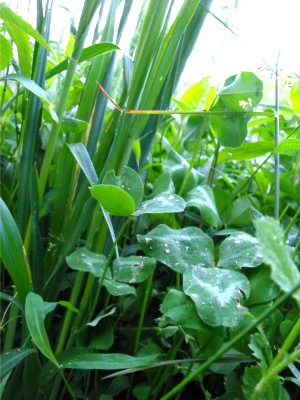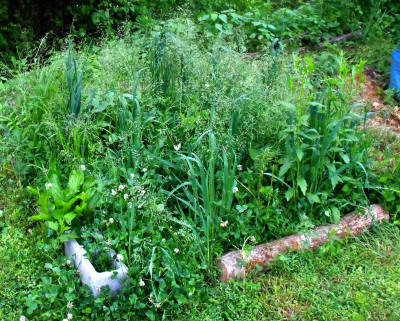
Do-nothing grain progress report
 It's
been months since I've talked about our do-nothing
grain experiment,
but what can I say, I've been doing nothing. You may recall that
I let the chickens churn up a couple of areas in the yard, then threw
down hull-less oat and red clover seeds in early March. For a
while, the weeds seemed to be growing faster than the grain and clover,
so I figured the experiment was a failure.
It's
been months since I've talked about our do-nothing
grain experiment,
but what can I say, I've been doing nothing. You may recall that
I let the chickens churn up a couple of areas in the yard, then threw
down hull-less oat and red clover seeds in early March. For a
while, the weeds seemed to be growing faster than the grain and clover,
so I figured the experiment was a failure.
I mowed down one plot
accidentally, but remembered to mark off the other small plot with
cinderblocks. And suddenly the oats have overtopped everything
else and the clover is starting to outcompete the weeds. This is
all with no tilling, no kill mulch, and no weeding.
Granted, this first
incarnation has too many flaws to be considered a success. There
are only about a dozen oat plants in my three foot by three foot plot,
presumably because I didn't cover the seeds with anything and hungry
critters made off with most of them. Fukuoka prevented this
predation by wrapping the seeds in balls of clay, but I suspect just
raking them into the soil a bit better or covering them with straw
might do the trick.
 There
are also plenty of weeds mixed into the plot, but I consider this less
of a problem. The clover and oats are clearly doing better than
the weeds, and I think a few generations of do-nothing gardening might
clear out the unwanted visitors in the plot.
There
are also plenty of weeds mixed into the plot, but I consider this less
of a problem. The clover and oats are clearly doing better than
the weeds, and I think a few generations of do-nothing gardening might
clear out the unwanted visitors in the plot.
I'm gearing up for a
second do-nothing grain experiment shortly, using the buckwheat/wheat
rotation that seems
better adapted to our climate. Mark fenced
our cockerels out of two thirds of the chicken pasture last week, and the flock is
finally starting to denude their remaining space. In a few weeks,
we'll rotate the chickens out, rake up the ground, and sow some
buckwheat and clover seeds for do-nothing experiment part two.
| This post is part of our Farm Experiments lunchtime series.
Read all of the entries: |
Want more in-depth information? Browse through our books.
Or explore more posts by date or by subject.
About us: Anna Hess and Mark Hamilton spent over a decade living self-sufficiently in the mountains of Virginia before moving north to start over from scratch in the foothills of Ohio. They've experimented with permaculture, no-till gardening, trailersteading, home-based microbusinesses and much more, writing about their adventures in both blogs and books.
Want to be notified when new comments are posted on this page? Click on the RSS button after you add a comment to subscribe to the comment feed, or simply check the box beside "email replies to me" while writing your comment.
